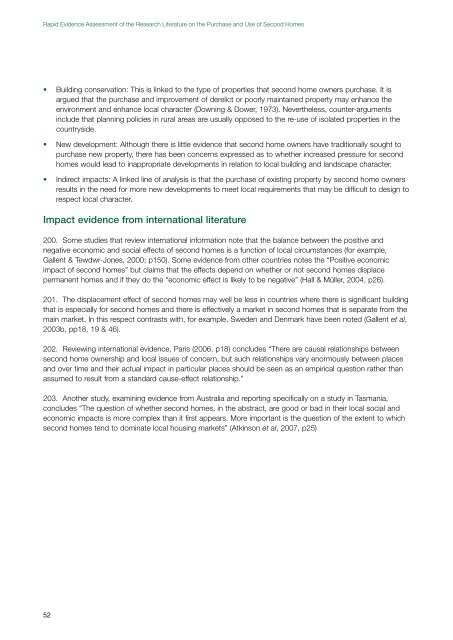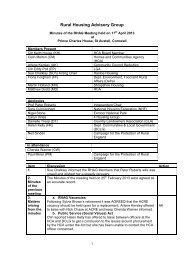Rapid Evidence Assessment of the Research ... - Rural Housing
Rapid Evidence Assessment of the Research ... - Rural Housing
Rapid Evidence Assessment of the Research ... - Rural Housing
Create successful ePaper yourself
Turn your PDF publications into a flip-book with our unique Google optimized e-Paper software.
<strong>Rapid</strong> <strong>Evidence</strong> <strong>Assessment</strong> <strong>of</strong> <strong>the</strong> <strong>Research</strong> Literature on <strong>the</strong> Purchase and Use <strong>of</strong> Second Homes<br />
• Building conservation: This is linked to <strong>the</strong> type <strong>of</strong> properties that second home owners purchase. It is<br />
argued that <strong>the</strong> purchase and improvement <strong>of</strong> derelict or poorly maintained property may enhance <strong>the</strong><br />
environment and enhance local character (Downing & Dower, 1973). Never<strong>the</strong>less, counter-arguments<br />
include that planning policies in rural areas are usually opposed to <strong>the</strong> re-use <strong>of</strong> isolated properties in <strong>the</strong><br />
countryside.<br />
• New development: Although <strong>the</strong>re is little evidence that second home owners have traditionally sought to<br />
purchase new property, <strong>the</strong>re has been concerns expressed as to whe<strong>the</strong>r increased pressure for second<br />
homes would lead to inappropriate developments in relation to local building and landscape character.<br />
• Indirect impacts: A linked line <strong>of</strong> analysis is that <strong>the</strong> purchase <strong>of</strong> existing property by second home owners<br />
results in <strong>the</strong> need for more new developments to meet local requirements that may be difficult to design to<br />
respect local character.<br />
Impact evidence from international literature<br />
200. Some studies that review international information note that <strong>the</strong> balance between <strong>the</strong> positive and<br />
negative economic and social effects <strong>of</strong> second homes is a function <strong>of</strong> local circumstances (for example,<br />
Gallent & Tewdwr-Jones, 2000; p150). Some evidence from o<strong>the</strong>r countries notes <strong>the</strong> “Positive economic<br />
impact <strong>of</strong> second homes” but claims that <strong>the</strong> effects depend on whe<strong>the</strong>r or not second homes displace<br />
permanent homes and if <strong>the</strong>y do <strong>the</strong> “economic effect is likely to be negative” (Hall & Müller, 2004, p26).<br />
201. The displacement effect <strong>of</strong> second homes may well be less in countries where <strong>the</strong>re is significant building<br />
that is especially for second homes and <strong>the</strong>re is effectively a market in second homes that is separate from <strong>the</strong><br />
main market. In this respect contrasts with, for example, Sweden and Denmark have been noted (Gallent et al,<br />
2003b, pp18, 19 & 46).<br />
202. Reviewing international evidence, Paris (2006, p18) concludes “There are causal relationships between<br />
second home ownership and local issues <strong>of</strong> concern, but such relationships vary enormously between places<br />
and over time and <strong>the</strong>ir actual impact in particular places should be seen as an empirical question ra<strong>the</strong>r than<br />
assumed to result from a standard cause-effect relationship.”<br />
203. Ano<strong>the</strong>r study, examining evidence from Australia and reporting specifically on a study in Tasmania,<br />
concludes “The question <strong>of</strong> whe<strong>the</strong>r second homes, in <strong>the</strong> abstract, are good or bad in <strong>the</strong>ir local social and<br />
economic impacts is more complex than it first appears. More important is <strong>the</strong> question <strong>of</strong> <strong>the</strong> extent to which<br />
second homes tend to dominate local housing markets” (Atkinson et al, 2007, p25)<br />
52






